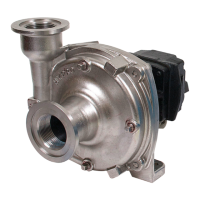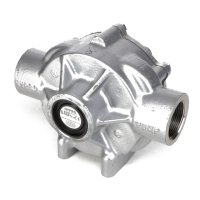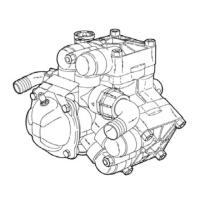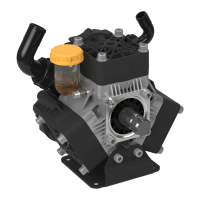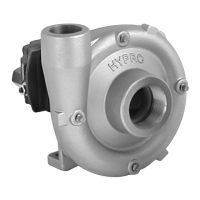5
plate, re place the cap screws,
and evenly tighten.
13. Using a pressure gauge with a
fill stem, pres sur ize the motor
housing to no more than 7 psig
with dried air and check for
leaks. If after several minutes
the gauge reads the same, the
seal is good and you can
con tin ue with assembly.
NOTE: It is normal to observe
some air bubbles in the seal
area initially as the seal seats.
If bubbles do not stop within
a few seconds, the seal is
either not properly installed or
is damaged.
14. Following the same procedure
outlined in steps 10 through
13, install the low er seal
assembly. Re place the impeller
using a re mov able locking
adhesive.
15. Reassemble the cut ters and
volute as outlined in the
Pump Disassembly,
Inspection, Reassembly
section of this manual.
16. Refill all cham bers with a
good quality di elec tric oil. Fill
the motor housing so that the
tops of the motor windings
have been covered (2500 ml),
but leave an air gap to allow
for ex pan sion of the oil.
Fill the seal chamber with 700
ml of oil so that an air gap also
exists.
Replacing Motor Stator:
1. If the replacement of the stator
is necessary, first follow the
disassembly steps outlined
in the previous sections of
the manual.
using the same method as used
for the lower seal, remove the
carbon seal assembly.
7. With a pair of screwdrivers,
pry up on the seal/bearing
plate. Remove the seal/
bearing plate until you have
access to the seal sensor wire,
then carefully pull the seal
sensor wire off the seal probe
which will allow the complete
removal of the seal bearing
plate.
8. Take a socket and tap out the
stationary portion of the seal
from the seal/bearing plate in
the same manner as used for
the lower stationary seal.
9. After checking both of the
O-rings, replace the seal
bearing plate in the motor
housing, making sure that
the seal sensor wire has been
reattached to the seal probe.
Use O-ring lube to prevent
cutting in assembly.
10. Take the sta tion ary portion
of the new seal, and lube the
rubber material with a good
quality dielectric oil. Press the
stationary portion of
the new seal into the seal/
bearing plate.
CAUTION: Do not reuse old seal
parts. Replace all parts with new.
Mixing old and new parts could
cause im me di ate seal failure.
11. Using a good quality dielectric
oil, lube the rubber material on
the carbon seal assembly and
press it on the shaft. Place the
spring
and the seal retainer on the
shaft as removed. Replace the
snap ring.
12. Carefully place the seal
housing onto the seal bearing
2. Remove the shaft rotor
assembly from the motor
housing, making note that a
wave washer is used on the top
of the upper bearing.
3. Place motor housing vertically
on the bench and remove the
cord grip. Carefully remove
the power cord from the pump,
making sure that the wires are
not damaged. Clip the power
cable leads, taking note of the
wire connections, and then
remove the power cable.
4. Turn the motor housing
over and remove the stator
bolts from the stator, then
remove the stator from the
motor housing.
5. Place new stator into the motor
housing while pulling the new
leads through the power cord
opening in the motor housing.
Replace the stator bolts and
tighten. Replace the seal
sensor wire along the side of
the stator.
6. Attach the power cord to the
stator leads and the sensor
leads using insulated butt
connector.Once attached,
carefully tuck
the wires into the motor
housing making sure that they
will not come in contact with
the rotor. Press the power cord
molded end into chamber in
the motor housing.
7. Apply a sealant to the threads
on the body of the cord grip
that will enter the motor
housing, then slide onto the
power cord and tighten snugly.
DO NOT OVERTIGHTEN.
Attach the cord grip nut onto
the cord grip and snug.

